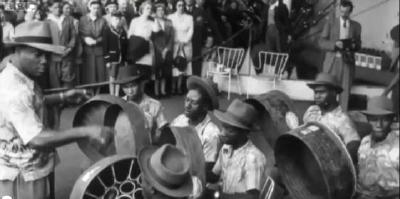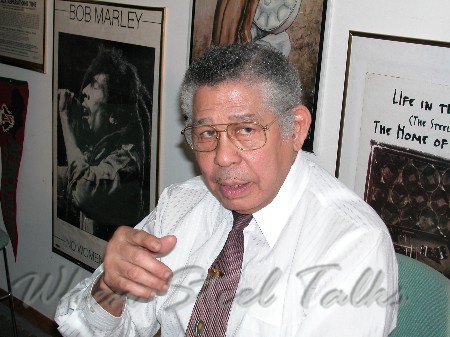
TASPO in Great Britain
This was a 1951 happening, definitely not of the “incidental” or “forgettable” variety – not for the steelpan world, not for the world of music, period. No, nothing of the sort for the experiment known as TASPO, the Trinidad All-Steel Percussion Orchestra (reportedly, Tobagonians had some issues with that name and that no player from Tobago had been selected, and vented their displeasure in lukewarm or non-existent support during the public drive for funds for the TASPO mission). Notwithstanding this, off TASPO went in July of ’51 to the U.K., primarily to appear in the Festival of Britain, the first representative group of Trinidadian panmen to take the steel band message well beyond the island’s shores.
So 60 years later, here’s Ellie Mannette, West Virginia University’s (WVU) resident steelpan guru, lucidly recalling the TASPO saga as if this were a last month occurrence. “It was the opening of the gates for steel band around the world,” Ellie is saying. “We performed in some very significant places -- Piccadilly Circus, Waterloo Bridge, Hyde Park and so on. People from all over the world visited these places, so they could talk about this unique new instrument from Trinidad called the steel drum when they went back to their countries.”
Ellie Mannette at WST Studios
The trail-blazing was being done by ten players and their plucky music director, Joseph Griffith, a former police band director. With 2011 having marked 60 years since the TASPO undertaking, the survivor ranks have of course thinned considerably. Griffith has been long gone and of the players, besides Ellie only Anthony Williams in Trinidad and Sterling Betancourt in England remain. Although as public knowledge, and even for so-called steel band enthusiasts, the critical significance of the TASPO tour tends not to be accorded its strategic position in pan history, Ellie, albeit not exactly a neutral party, won’t abide any short-shrifting of the esteem due TASPO. And he readily concurs with the view of pan researchers who credit Griffith for introducing fundamental changes to the steel band’s form and function, that pointed its way forward.

Sterling Betancourt
One of Griffith’s contributions held particular interest for Ellie, who was considered by many the era’s foremost name in pan tuning. He recalls Griffith telling the band about the need for the instruments to have chromatic range: “We didn’t know what chromatic was. We were doing all kinds of nonsense, doubling up on notes and that sorta thing. But Griffith taught us about chromatic.” Ellie says Griffith also gave him guidance on the tuning of the steel drum bass, as far as what range of notes the bass needed to have. Griffith expanded the group’s horizons repertoire-wise as well. “He showed us that the steel drum could play other types of music,” Ellie says, “and we didn’t have to play the calypso rhythm all the time. So he started showing us the Blue Danube waltz and other light classical pieces.”
Evidently bringing laser-like focus to the challenge of impressing foreign audiences with the group’s musicianship, and in a brand new medium to boot, Griffith had the men summon skills they had not previously tapped. Hear Ellie: “The third thing that was important was he showed us we could do improvisation. So when we were playing he would stop the band and have one of the guys get up and do a solo. He would point to Andrew De LaBastide or myself or Theodore Stephens and we would take a little solo. So that again was something different from what we did before.” The improvisation feature clearly did its share of turning heads. A comment by the music critic of the Manchester Guardian about TASPO’s rendition of Toselli’s Serenade was reproduced in the Errol Hill book, The Trinidad Carnival: Mandate for a National Theatre: “The playing is wonderfully skilled and there are many short solo passages as in virtuoso jazz.”

TASPO in Great Britain
Small wonder that despite all he has accomplished in the intervening years, Ellie continues to have an undiminished respect and fondness for the TASPO experience, both his personal involvement as member of an elite unit and the group’s exploits that proved to be such a great foundation builder for a then fledgling art form. Now in his mid-80s, Ellie indomitably ploughs on, still very much a pivotal presence in the pan world he has known, he proudly lets on, “since 1937 when I was looking at Alexander’s Ragtime Band and watching stick fighting and all that stuff. People tell me I haven’t slowed down. I tell them there’s no need to slow down. I work with a bunch of young kids and they keep me alive.” An adjunct professor and artist in residence at WVU, his formal affiliation with the school began in 1992. Through the years he has been imparting knowledge (“from A to Z”) to students about building and tuning steelpan instruments and is proud of several of his students being able to hold their own as instrument makers. He lectures, both at WVU and elsewhere, about steel band lore and the Trinidadian cultural environment that made it possible.
All the while, the inimitable Mannette touch is brought to bear on the impeccable instruments he turns out for folks – individuals as well as institutions -- from all around the country and worldwide who care for nothing less than the imprimatur of a peerless master. Substantiating the nonpareil space he occupies have been citations and awards from the U.S. Congress, Smithsonian Institution, National Endowment for the Arts, Percussive Arts Society and a host of others.
Ellie is of course appreciative that fate has dealt him bountiful good fortune that has allowed him to bear first-hand witness to the steelpan’s odyssey for as long as he has. As he sees it, the TASPO chapter will forever remain central to the narrative. After their many performances on English soil, their extended tour an unqualified success, the band was invited to appear with the Medrano Circus in Paris. There again TASPO continued to wow audiences, so much so as to get an offer from the Medrano people to move on with the circus to Italy. Paris, however, turned out to be as far as the group would strut their stuff. “Some of the guys wanted to continue, but some of us were getting homesick,” Ellie recalls. “They were trying to encourage me to stay but I wanted to get back home.” Ellie says Griffith felt the band should have embraced the opportunity to project the new art form even further, and was not pleased the tour had to be terminated when it was. “He was upset with us,” Ellie says, in explaining that after the band returned to Trinidad (minus Betancourt, who chose to remain in England) in December that year, Griffith had no further interaction with the members.
TASPO’s role as the first major overseas ambassadors for the steel band is unquestioned. Long before their numbers dwindled to today’s precious three, the TASPO veterans would invariably speak to the great musical leap that, as a unit, they made under Griffith’s inspired leadership. Never mind any schism, in Ellie’s invaluable recounting, that may have climaxed their historic 1951 triumph, the men of TASPO obviously came out of that experience with assets from which the steel band movement benefited substantially in the process of finding its singularly exciting place in musical culture.
Leave your comment in the WST forum
Click for more on TASPO






